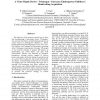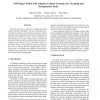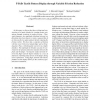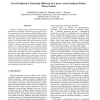113
Voted
HAPTICS
2007
IEEE
15 years 7 months ago
2007
IEEE
This work focuses on the relative importance of skin stretch imposed on the fingerpad on the perception of friction. Perceptual data is presented from two separate tests. The fi...
99
Voted
HAPTICS
2007
IEEE
15 years 7 months ago
2007
IEEE
Volume haptics has shown itself an effective way of enhancing precision and speed in interaction with medical or scientific visualization. This paper presents a mixed solver appr...
HAPTICS
2007
IEEE
15 years 7 months ago
2007
IEEE
The objective of the present research was to show that incorporating a visuo-haptic device ‘Telemaque’ may increase the fluency of handwriting production of cursive letters in...
HAPTICS
2007
IEEE
15 years 7 months ago
2007
IEEE
In teleoperation systems, link flexion results in kinematic errors, such that the position mapping between the master motion and slave motion is not correct. For haptic feedback ...
90
Voted
HAPTICS
2007
IEEE
15 years 7 months ago
2007
IEEE
This paper presents a method for building analytical contact models for soft fingers. Friction constraints are derived based on general expressions for non-planar contacts of ela...
123
Voted
HAPTICS
2007
IEEE
15 years 7 months ago
2007
IEEE
In this paper we discuss the theory, design and construction of a haptic display for creating texture sensations through variations in surface friction. Ultrasonic frequency, low ...
111
Voted
HAPTICS
2007
IEEE
15 years 7 months ago
2007
IEEE
This paper describes the use of a magnetic levitation haptic device (MLHD) to study the psychophysics of texture roughness. Studies of texture roughness perception performed using...
100
Voted
HAPTICS
2007
IEEE
15 years 7 months ago
2007
IEEE
A method based on Principal Component Analysis of the fingernail coloration pattern is presented to infer fingertip force direction during planar contact. Images from 7 subjects...
137
click to vote
HAPTICS
2007
IEEE
15 years 7 months ago
2007
IEEE
Realistic modeling of the interaction between surgical instruments and human organs has been recognized as a key requirement in the development of high-fidelity surgical simulato...
83
Voted
HAPTICS
2007
IEEE
15 years 7 months ago
2007
IEEE
Earlier work with a 1-D tactile transducer demonstrated that lateral skin deformation is sufficient to produce sensations similar to those felt when brushing a finger against a ...








